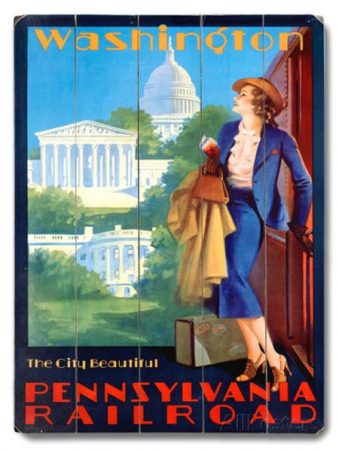Railroad travel fluctuates in rough harmony with the general disturbances in the national economy we call business cycles. The relationship becomes evident if changes in passenger miles are compared with the upswings and downswings in business outlined by the National Bureau’s ‘reference’ chronology. A more satisfactory comparison can be made for the period since 1918 than for earlier times, as information is more detailed for recent cycles: March 1919 is the first month for which the number of passenger-miles has been compiled and published. Before then the total amount of travel was recorded in annual statistics only. We shall examine the monthly data first.
The course of railroad travel since 1919 is divided into phases of growth and decline by asterisks, one at each peak or trough. Dates the National Bureau regards as troughs in business at large are indicated by solid, and those it regards as peaks by broken vertical lines. Each interval from a solid to a broken line represents a business expansion, in which, presumably, a more or less general growth of employment, production, trade, and income occurred. The space from a broken to a vertical line represents a period of general decline, or business contraction.
Except for the 1919-20 and 1933-37 expansions, each phase of business can readily be matched with a corresponding phase of travel. For example, a few months after the business contraction of 1920 began, travel started to decline, and continued to do so during the remainder of the business phase and for some time thereafter. Differences between the turning dates in a particular form of economic activity and the ‘reference’ turns of the chronology are not uncommon. Indeed the dates of the business peaks and troughs are necessarily somewhat arbitrary; not all kinds of activity, even among those which clearly follow the reference cycles in a general way, reach peaks or troughs in exactly the same month.
There were no real exceptions even in 1919-20 or 1933-37. We have not marked any trough in passenger-miles corresponding to the reference trough of April 1919. But monthly data on the revenue railroads derived from the transportation of passengers suggest that there was a trough in October 1918. As will presently appear, statistics of Pullman traffic show such a trough. We conclude that there was an expansion in total passenger-miles corresponding to the business expansion of 1919-20, although it began considerably earlier.
During the long reference expansion of 1933-37, we have marked off not one but three phases in travel. It rose to a peak in October 1934, declined thereafter, and subsequently rose to a final peak in March 1937. The intermediate peak was not as high as the final one, the intermediate trough not as low as the initial one. It is fair to say that during the period as a whole there was an expansion in travel corresponding to the reference phase.
What is true of passenger traffic as a whole is equally true of its principal component, travel other than commuting. Beginning with the 1921-23 expansion, there was a specific phase for every reference phase. In arriving at this judgment we again disregard a mild specific contraction during the long expansion of 1933-37.
‘Other than commutation’ travel includes journeys in Pullman cars, for which we have monthly data beginning early enough to cover practically the entire 1914-18 business expansion. Here again each reference phase can be matched by a specific phase. A long expansion in Pullman passenger-miles, beginning before and ending after the reference expansion of 1919-20, is clearly defined. Again, three phases in 1933-37 can be lumped into a single longer phase corresponding to the business phase.
The 1914-18 expansion presents a somewhat similar situation. There was a trough somewhat before the data begin in January 1915, lower than the trough we have marked in January 1916. This is exactly what we find in data on the revenue of the Pullman Company, which begin somewhat earlier. We conclude that there was a long rise from late 1914 to November 1917 which, although interrupted, corresponds to the 1914-18 reference phase.
It is not so obvious that there are fluctuations in commutation travel corresponding to those in business. Consequently we can’t say that every reference phase was matched by a specific phase. But we can approach the problem in a somewhat different way by asking whether there was a net rise during each business expansion and a net decline during each contraction. We find a net rise in three of four expansions, but a decline in 1933-37; also a net decline in three of four contractions, but practically no change in 1926-27.
Since there are few cases altogether, these exceptions look formidable. Even though an economic activity rises in both an expansion and a contraction, however, it may rise more rapidly in the former. We regard such a difference in rates of growth as analogous to the difference between a rise in expansion and a fall in contraction. The resemblance is still closer if the activity rises in expansion but remains unchanged in contraction. Finally, the activity may decline in both phases, but more rapidly in contraction. Such a difference in rates of decline is also analogous to that between rise and fall. If an activity fairly consistently does one or another of these four things we say that it conforms positively to business cycles.
For commuting the data permit us to make seven comparisons between a reference phase and the following phase of opposite character. We can compare the expansion of 1921-23 with the contraction of 1923-24, the latter with the expansion of 1924-26, and so forth. Every one of the comparisons suggests positive conformity of one kind or another. If 1924-26 is compared with 1926-27, or 1926-27 with 1927-29, we find growth in expansion but none in contraction. If we compare 1933-37 with either the preceding or the following phase we find more rapid decline in contraction than in expansion. There was perfect positive conformity.
Nevertheless it is somewhat curious that commuting did not decline at all in 1926-27. In the decade after 1920, however, this kind of traffic was subject not only to changes in the prosperity of actual or potential commuters but also to another influence. During the 1920’s, although not during the ’30’s, the population of suburban areas, and presumably the number of potential commuters, grew rapidly.
It Is also remarkable that commuting should have declined, even slightly, during 1933-37, when other kinds of travel and economic activity at large were showing pronounced recovery. But after 1929 many highway improvements especially designed to facilitate the flow of motor traffic in a metropolitan region were made in and around New York and no doubt in other commuting areas. Some were completed during 1933-37. They increased the relative attractiveness of driving to work in comparison with commuting by train. Even if a traveller chose to go to and from his job by railroad, it was no longer so advantageous to buy a commutation ticket rather than pay for each trip separately.
Other fares had been greatly reduced; commutation fares had not changed much. In 1933-37 ordinary fare exceeded commutation fare by about 1 cent per mile; in earlier expansions the spread was 2 cents. Under some circumstances the difference was nominal. The average commutation fare per mile is computed on the assumption that purchasers of monthly tickets make full use of them. Some persons had occasion to go into town only two or three times a week or preferred to drive in good weather.
For them the price of a monthly ticket, divided by the number of trips actually taken, may have exceeded the new low level of noncommutation fares. Some travel was probably diverted to the ‘other’ category. Finally, migration to the suburbs did not add to the number of potential daily riders as rapidly as in the 1920’s. All these factors help to explain the absence of any marked expansion in commuting.
Visits: 59



